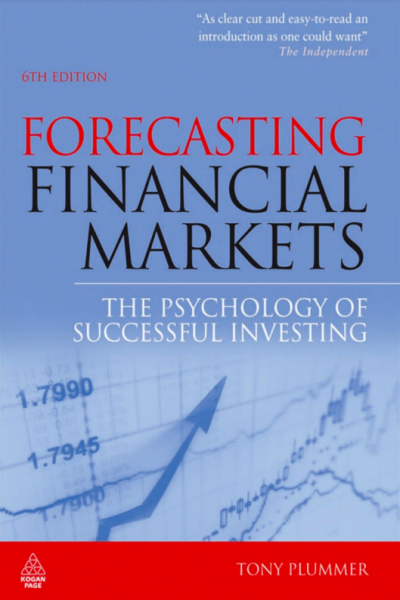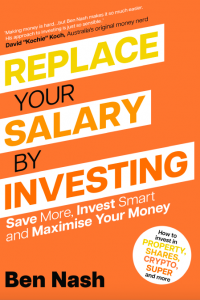Forecasting Financial Markets: The Psychology of Successful Investing Sixth Edition
Sách Dự Đoán Thị Trường Tài Chính và Tâm Lý Trong Đầu Tư.
Đặt in thành sách tại HoaXanh, xem sách in mẩu trong video bên dưới.
- 160,000đ
- Mã sản phẩm: P85035
- Tình trạng: 2
The logic of non-rational behaviour in financial markets
1 Wholly individual or indivisibly whole
The relationships in nature; The break with tradition; The conceptual revolution; The problem of motivation; The dualistic nature of motivation;
2 Two’s a crowd
The influence of groups; The insights of Gustave Le Bon; The group’s ability to organize itself; Mind as a dynamic principle; The group mind; The triune human brain; The neocortex; The amygdala; The response to a threat;
The ‘intelligence’ of crowd
3 The individual in the crowd
The integrative tendency ; Identification ; Beliefs ; Self-awareness and confirmity enforcement ; The crowd leader ; The findings of Stanley Milgram ; Altruism and conflict; Splitting and projection;
4 The systems approach to crowd behaviour
Non-equilibrium conditions; Openness to the environment: the exchange of energy; Openness to the environment: the exchange of information; The mechanism for transmitting information; Feedback loops and the transformation of information; Oscillating systems; The role of the crowd leader ; The interrelationship between a crowd and its
environment ;
5 Cycles in the crowd
The life cycle ; Co-evolution ; Limit cycles ; Limit cycles through time ; Limits cycles in nature ; Multiple limit cycles; Multiple cycles in two dimensions ; The impact of shocks ; The profile of shocks ; Shocks in two dimensions ; Some insights into social change
6 Approaches to forecasting crowd behaviour
Random or non-random ; Price movements in the Dow ; Strange attractors ; Predictable price movements ; Methods of predicting price movements ; Economic forecasting ; Problems with economic forecasting ; Problems with conceptual framework ; The rational expectations hypothesis ; Bubbles and crashes ; Non-linear mathematics ; The challenge to economic theory ; Technical analysis ; The past and present as a guide to the future ; The
rationale behind technical analysis
The dynamics of the bull–bear cycle
7 The stock market crowd
The individual investor; The dealing strategy; The financial market crowd; The influence of emotions; The herd instinct; The mechanism of price fluctuations; The bull–bear life cycle in emotions; The objectives of technical analysis; The influence of price movements on crowd psychology; The contest between the two crowds; The influence of prices on behaviour; The shift from isolation to belonging ; The limit cycle between prices and
behaviour; Beliefs and leadership ; Individuals as crowd leaders ; The conditions for effective leadership ; Investment advisers ;
8 The shape of the bull–bear cycle
The limit cycle between prices and sentiment ; The bias in the limit cycle ; The influence of ‘external’ factors ; The limit cycle between equity markets and the economy ; The influence of shocks ; Pro-trend shocks ; Contra-trend shocks and energy gaps ; Shocks and the limit cycle ; The return to the limit cycle ; Practical implications ; The pattern of adjustment after troughs ; The reversal process ; The idealized three-stage reversal pattern ; The influence of fear ; The bias in the bull–bear cycle ; Asymmetric investment attitudes ; The price pulse ; The time
hierarchy ; Price–sentiment limit cycles ; Limit cycles and the transmission of shocks ; The hierarchy of fluctuations ;
9 Energy gaps and pro-trend shocks
Energy gaps ; Bridging energy gaps; Bridging the first energy gaps in financial markets ; Bridging the second energy gap in financial markets ; The importance of timing ; Pro-trend shocks in financial markets ; Energy gaps and information flows ; Changes in the quality of information ; Identifying the shock point ; The pattern of a trend
10 The spiral and the golden ratio
The mathematics of the spiral; The Fibonacci number sequence 125; Fibonacci’s rabbit problem 126; The Fibonacci sequence and nature 126; The properties of the Fibonacci sequence 127; The important ratios 128; The golden ratio 128; The golden ratio in geometry 128; The golden mearure and the human body 129; The golden measure in nature 130; Three terms from two 130; The golden rectangle and the golden ratio 131; The spiral of rectangles 132; The golden spiral 132; Properties of the golden spiral 133; The golden measure and ancient religious insight 134; The ‘laws’ of life 135; Information and the human mind 135; Recognizing information 136; Understanding by
analogy 136; Creative insight 137; Self-organizing hierarchies 137; Metaphor and reality 138; Financial market crowds 139; The golden measure and financial markets 140
11 The mathematical basis of price movements
The calculation of price targets 143; The application of the target formula 144; Examples from the UK gilt-edged market 146; additional examples 148; Examples from the US Treasury bond market 151;
12 The shape of things to come
Examples 155; Price and momentum 158; Momentum examples 159; Imitations of cyclicality 160;
Stylized patterns 162; Asymmetry 162;
Forecasting turning points
13 The phenomenon of cycles
The influence of groups; Satiation; Transformation of energy and information; The patterns that connects; Tracking the cycle 171; Momentum indices 171; Momentum and the cycle 172; Anticipating inflexion points 173; Velocity and non-confirmation 174; Acceleration and the cycle 175;
14 The threefold nature of cycles 178
The 111⁄2 -year cycle in the Dow 178; Idealized cycles 181; Comparing the cycles 182; The 111⁄2 -year cycle and the panic of 2008 186; Actual cycle timings 188; The four-year cycle in the Dow 189; Triads, dyads and energy gaps 189; The 1987 Crash 190; Confirming the energy gap 193; The Wall Street Crash 193; Cycle characteristics 194; Cycle functions 195; Cycle translation 196; Translations within a triad 196; The influence of higher-level cycles 197; Cycle biases and energy gaps 198; Cycle behavioural traits 199; Behavioural traits in a base cycle 199; Behavioural traits in a trend cycle 200; Behavioural traits in a terminal cycle 200; A schematic for financial markets 201; Limited cycle patterns 202;
15 Economic cycles 205
Note on economic theory; An integrative view; Relationships between economic cycles; From Kitchin to Strauss and Howe; Strauss and Howe to Kitchin 208; Kuznets and Kondratyev 209; Economic theory and technical analysis
210; Cycle characteristics 211; Biases in cycles 211; An example from history 213; Juglar cycles during the 1946
to 1980 Berry cycle 213; Theory and fact 214; The first cycle 215; The second cycle 215; The third cycle 216;
Evolution 217; Labelling the cycles 218; Conclusion 219
16 Recurrence in economic and financial activity 221
Economic and financial market cycles ; Searching for cycles ; The 1866–94 cycle ; The 1894–1921 cycle ; The 1921–46 cycle; Strauss and Howe meta-cycle ; The Berry terminal cycle 227; The first Juglar cycle 228; The second Juglar cycle 228; The third Juglar cycle 229; Confirming the 1946 low 229; The 1946–80 Berry adaptation
cycle 230; The 1970–80 Juglar cycle 231; The Kitchin triad 231; The post-1980 Berry regeneration cycle 233;
The Juglar transition and innovation cycles 234; Kitchin cycles in the Juglar innovation cycle 235; The Juglar
disruption cycle 235; Kitchin cycles in the Juglar disruption cycle 237;
17 Integrating the cycles 240
Historical schematic 240; Historical experience 242; Survey of the schematic diagram 243; The differing nature of upswings and downswings 245; Using the schematic diagram 246; Disruption vs depression 247; The next Berry crisis cycle 248; Kondratyev cycles 248; The post-1949 Kondratyev cycle 251; Price cycles and output cycles 253; Kondratyev, Berry, and Strauss and Howe 254; Juglar disruption and Berry crisis 255;
18 Forecasting with cycles 259
Introduction 259; The post-1980 Berry cycle 259; Cycle alignment 260; Sentiment in a Juglar innovation cycle
261; Sentiment in the Juglar disruption cycle 262; Comparisons with previous terminal cycles 263; Comparisons with averages of previous cycles 265; Financial markets and the economy 266; Conclusion 268
19 Price patterns in financial markets 269
Hierarchical trends 269; Markets and fundamental trends; Economic cycles, price patterns and price trends 271; The pattern of a trend 271; The five–three wave pattern in complex structures 272; The Elliott wave principle 273; Investment guidelines 274; The buy signal after a low 274; Warning of a bear phase 275; The terminal cycle 276; The location of corrections 277; The strength of a contra-trend rallies 279; Non-confirmation revisited 279; Anticipating turning points 281; The golden ratio formulae 281; Some examples 282; Conclusion 284
20 The Elliott wave principle 285
Elliott’s discovery; The price pulse as the basis of the wave principle ; The basic wave pattern ;
Corrections ; A universal phenomenon ; The wave principle as a natural phenomenon ; Derived rules: trend indications ; Derived rules: impulse waves ; Derived rules: corrections ; Complications within the system; Fifth-wave variations: failures and extension; Behaviour following failure or extension; Fifth-wave variations: diagonal triangles; Variations in corrections: the three-phase A-wave ; The flat correction; Complex corrections; Triangles ;
The implications of a triangle; Inverted corrections; The ‘rule of alternation’ ; The problem with the
Elliott wave principle
21 Information shocks and corrections 301
Information shocks; Information shocks and a five-wave trend 302; Shocks and cycles; Information shocks and boundaries; Corrections and shocks 306; The golden ratio boundaries 308; Technical corrections and fundamental reversals 308; Top retractments 309; Base retractments 311; Corrections and trend reversals 312; The 1987 Crash and the 2000–02 bear 312; Hierarchical structuring 313; Guidelines for calculating boundaries 315; Pro-trend shocks 316; A practical example 318; The base pattern 318; The wave 4 correction 319; The dollar–yen bear market 320;
22 The confirmation of buy and sell signals 323
Investor confidence and price flucuations; Overextended markets and the principle of non-confirmation; Indicators of investor behaviour; Volume and open interest; The level of volume; The level of open interest; Sudden changes in indicators; The direction and change in volume and open interest; Changing emotions during the cycle; Sharp rises in volume and open interest; The reversal process; Volume and open interest during fifth waves; Volume and open interest during re-tests; The wider implications of falling open interest; Momentum and overextended markets; Momentum and non-confirmation; Measures of momentum; Rates of change; Deviations from a moving average; The relative strength index (RSI); Momentum trading rules ; The directional indicator; The
advance–decline index 338; A second price index ; The principle of direct confirmation: the Dow theory ; The principle of direct confirmation: other indicies
The psychology of trading
23 The psychology of fear
The subconscious mind; The role of habits ; The response to a threat ; Stress ; The influence of emotions ; Beliefs and memories ;
24 The troubled trader
The three-part mind ; The psychological matrix; Basic personality types; Primary behavioural characteristics ; The gut-oriented personality ; The heart-oriented personality ; The head-oriented personality ; The chink in the ego’s
armour ; Basic motivations ; Avoidance compulsions ; Response strategies ; Some awkward personal questions ; The threat from financial markets; Financial markets and personal space; Financial markets and the self-image; Financial markets and fear; The emergence of the crowd;
25 The psychology of success
Basic requirements ; Goal-setting ; Goals for the trader ; Practical considerations ; The five aspects of effective goal-setting ; Converting desires into actual beliefs ; Visualization; Writing down and affirmations ;
Strategy for achieving goals ; Strategies for traders; Method ; Energy ; Physical health ; Mental and emotional health ; Stress ; Relaxation techniques ; Conclusion
26 Summary and conclusions



